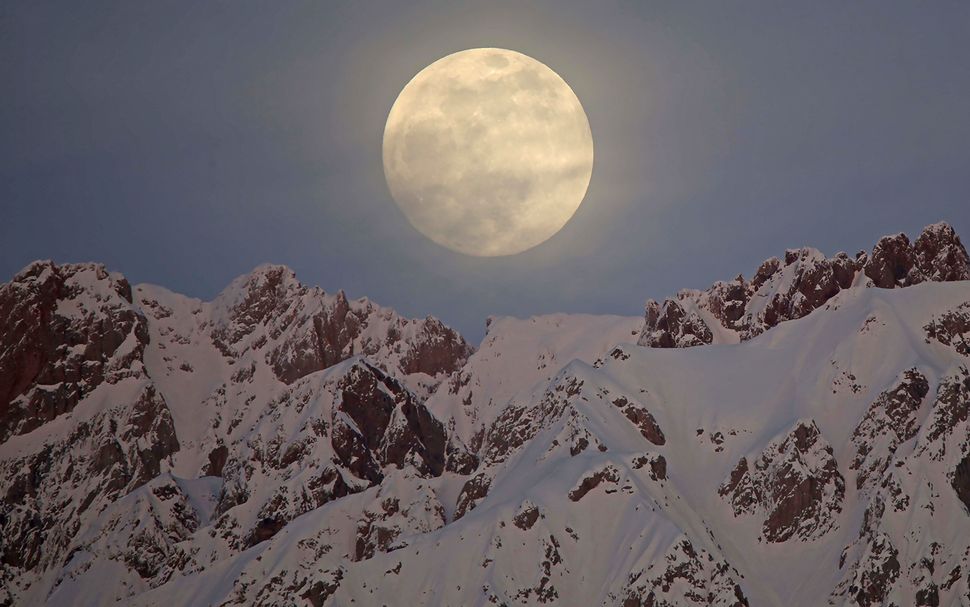nivek
As Above So Below
Tomorrow night is it although it looks full tonight...

February Full Moon 2019: The 'Super Snow Moon' Brings Planetary Conjunctions and Other Celestial Treats
The full moon of February, called the Snow Moon, will occur in the U.S. during the morning of Feb. 19. It will be at its fullest about 6 hours after reaching perigee, the nearest point from Earth in its orbit — creating a "supermoon," a full moon that is slightly larger than average.
The moon becomes officially full on Feb. 19 at 10:53 a.m. EST (1553 GMT), according to NASA's SkyCal. For skywatchers in New York City, the moon will rise at 5:46 p.m. on Feb. 19 and set the next day at 7:35 a.m., according to the U.S. Naval Observatory (USNO). The moon will be in the constellation Leo, and it will rise about 10 minutes after sunset.
The full moon happens when the moon is on the opposite side of Earth from the sun. Most of the time the moon is fully illuminated by the sun's light. Once in a while, though, the moon's orbit carries it within the shadow of Earth, as happened in January during the "Super Blood Wolf Moon" total lunar eclipse. [Amazing Photos of the Super Blood Wolf Moon of 2019!]
When the moon enters the Earth’s shadow it doesn’t go completely black — it turns a deep red color because of light refracted through the Earth’s atmosphere. (If you were standing on the moon you would see the sun eclipsed by the Earth, and the Earth would be surrounded by a bright red-orange ring). February's full moon will "miss" Earth's shadow, because the moon's orbit is slightly tilted (or inclined) 5 degrees with respect to the plane of Earth's orbit, and therefore the Earth won't be directly between the sun and the moon.
Though there won't be another eclipse in February, the full moon will be a "supermoon" — which means it will appear about 10 percent larger than average, because on Feb. 19 at 4:06 a.m. EST (0906 GMT) the moon will reach perigee, the closest point in its orbit around the Earth. The average distance between the moon and Earth is about 240,000 miles (385,000 kilometers). At perigee, that distance is about 220,000 miles (350,000 km), whereas at apogee it is about 406,000 km (250,000 miles). During this supermoon, the moon will be 221,681 miles (356,761 km) from Earth, according to timeanddate.com. It will be the closest perigee of 2019, and it's the second supermoon of the year.
Through binoculars or a small telescope, the full moon will appear almost unbearably bright. While the brightness isn't dangerous to one's eyes, it can be hard to spot details on the lunar surface. That is due to the lack of shadows to give any contrast. That said, moon filters are available that can make some features, such as major craters, or the lunar maria (the dark-colored regions), stand out better. If one waits a few days after the full moon or observes a few days before, it's easier to see the features at the edge of the lunar disk, when the shadows start to bring out more detail. [Infographic: How to Observe the Moon]

Being in the constellation Leo, the full moon will be in conjunction (sharing the same celestial longitude) with the star Regulus, the brightest in that constellation. The moon will appear to pass about four to five lunar diameters (about 2.5 degrees) north of the star. The conjunction occurs at 8:08 a.m. EST (1308 GMT) on Feb. 19.
On the east coast of the U.S., the sun will be up before the conjunction occurs, but observers in the Rocky Mountain states and westward will be able to catch the conjunction. In Denver, the conjunction will occur at 6:08 a.m. MST, about 40 minutes before sunrise. Residents of the Pacific Coast can see the conjunction at 5:08 a.m. local time, with the sunrise coming earlier the farther one moves south. For example, in Seattle, the sun will rise at 7:08 a.m. PST, while in Los Angeles the sun will rise at 6:34 a.m. PST. Hawaii has the longest period between sunrise and the conjunction; the conjunction itself is at 3:08 a.m. HST and the sun rises at 6:59 a.m. HST.
(More on the link)
.
